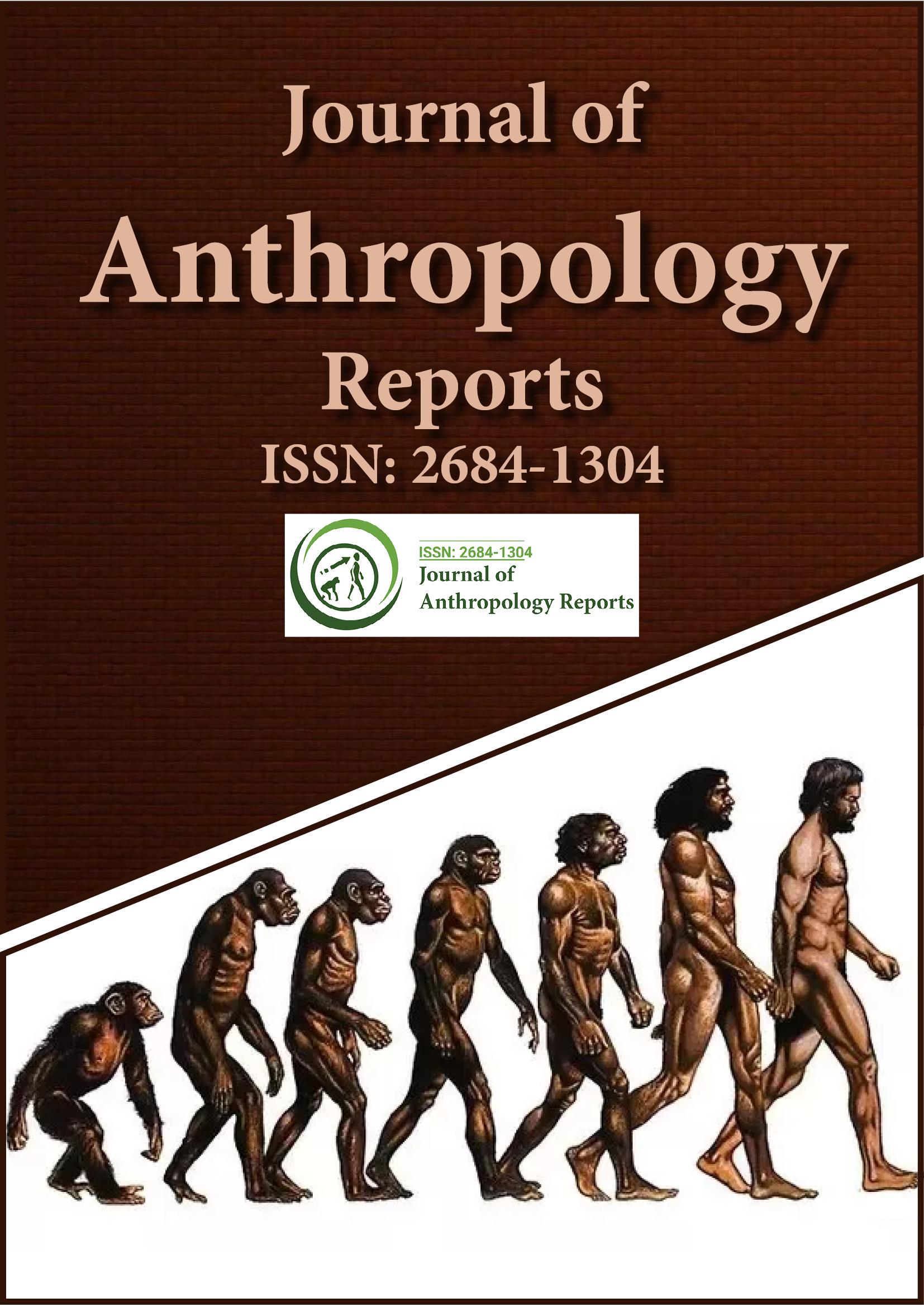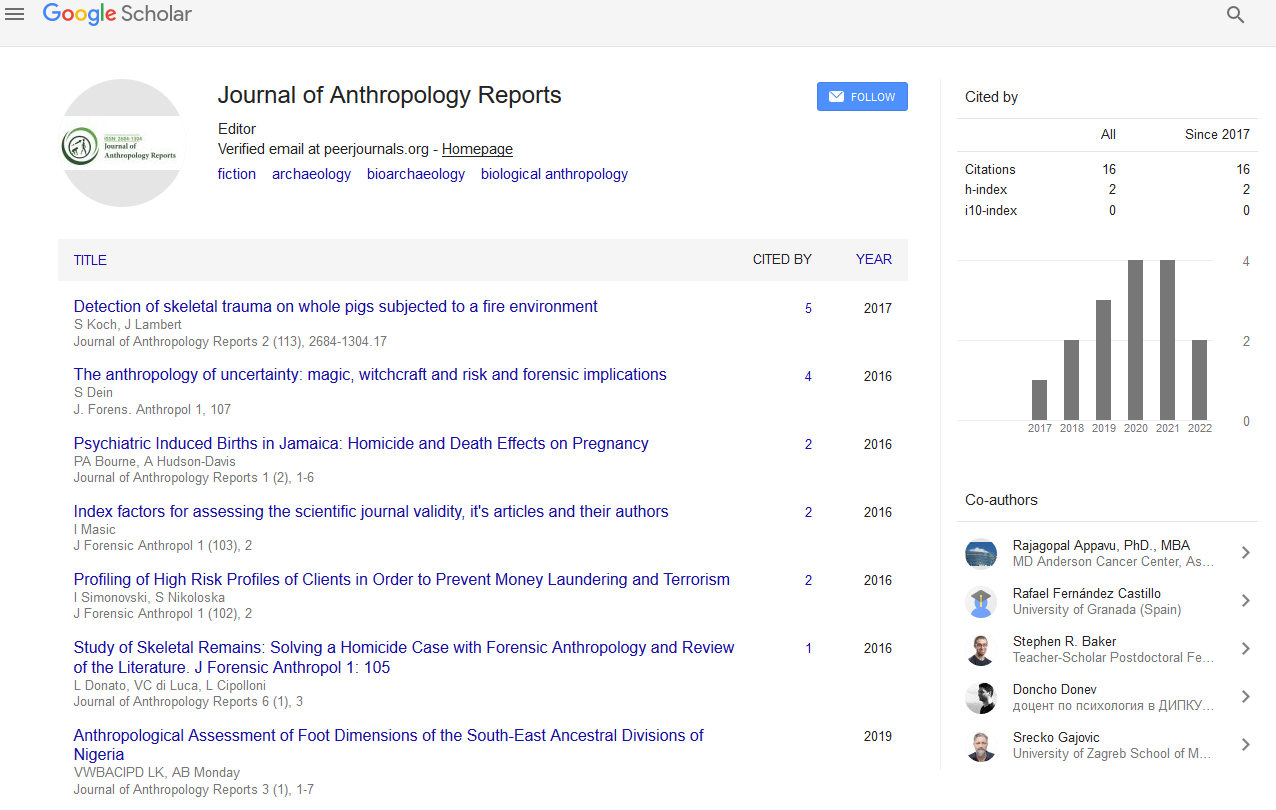Indexed In
- RefSeek
- Hamdard University
- EBSCO A-Z
Useful Links
Share This Page
Journal Flyer

Open Access Journals
- Agri and Aquaculture
- Biochemistry
- Bioinformatics & Systems Biology
- Business & Management
- Chemistry
- Clinical Sciences
- Engineering
- Food & Nutrition
- General Science
- Genetics & Molecular Biology
- Immunology & Microbiology
- Medical Sciences
- Neuroscience & Psychology
- Nursing & Health Care
- Pharmaceutical Sciences
Opinion Article - (2024) Volume 7, Issue 2
Modern Homo sapiens through Fossil Evidence and Molecular Biology
Yuki Sato*Received: 28-May-2024, Manuscript No. JFA-24-26530; Editor assigned: 31-May-2024, Pre QC No. JFA-24-26530 (PQ); Reviewed: 14-Jun-2024, QC No. JFA-24-26530 (QC); Revised: 21-Jun-2024, Manuscript No. JFA-24-26530 (R); Published: 28-Jun-2024, DOI: 10.35248/2684-1304.24.7.195
Description
Advancement is all around us and managing billions of years in the living environment, yet the remarkable human mind continues to seek the missing connections. After Darwin proposed the hypothesis of regular choice for the beginning of species, paleontological confirmations were the main assets accessible to the researchers in various fields to concentrate on the qualities of an animal varieties and the varieties throughout specific time. It was particularly remarkable that Carolus Linnaeus after some cautious perception set chimps and people in a similar family Hominidae and furthermore gave the logical name of the people, Homo sapiens in around the late eighteenth century. Beginning from that time academic local area confronted serious analysis from various corners of the general public with religious viewpoints. Indeed, even after all the analysis, Linnaeus didn't change the taxonomical progressive system for people, just adjustment he did was the presentation of Class Mammalia and request primates. Bipedalism and the bigger mind have isolated the Hominin family from the primates and extraordinary gorillas like gorillas and chimpanzees and maintained Linnaeus' taxonomical situation of Homo sapiens. After the Hominin bunch got separated from Panina (chimpanzees) around 7 mya, the conspicuous gathering from which current people have advanced (1.9 mya-70,000 ya) were first called Pithecanthropus erectus; then being altered to Homo erectus (as per some alluded as Homo ergaster).
Alongside the upstanding component they have been viewed as utilizing fire and complex devices. From this gathering, the antiquated people have been advanced which incorporates Homo heidelbergenesis, Homo rhodesiensis and the latest one is the Homo neanderthalensis. Major unmistakable element among Pithecanthropus and Old People is the development of the head accordingly the size or mass of the mind. The primary known fossil of physically present day human known as "The Red Woman of Paviland" was found by William Buckland in Paviland Cavern, joined realm in 1823. The interesting truth was Buckland was a scholar yet additionally a scientist and geologist. From that point onward, consequently every one of the fossils found of H. sapiens were from various pieces of Europe like France, Czech Republic (1894), and so forth. So for quite a while scientists held areas of strength for a that the beginning of H. sapiens happened at various pieces of Europe and Asia. This idea was tested when the skull of a youthful Australopithecus Africans named "Taung Kid" was found in Taung, South Africa by Raymond Dart and promptly recognized as the missing connection between the gorillas and the human. This revelation plainly upheld the expectation of Darwin that Africa is the spot for the beginning of species H. sapiens. So the "Taung youngster" tested the common thought regarding the beginning of current people in Eurasia. Dart's discoveries were excused for a long while and afterward in the end acknowledged by mainstream researchers later in the 20th hundred years.
Progressively in late 1950s various other fossil bones were found in a cavern from the upper east of Johannesburg, Africa which underlined the way that the support of human beginning is Africa. The fossil of most seasoned hominin (accepted to be more than 3 million years old) was viewed as later in 1974 by paleoanthropologist Johanson from Far off Triangle, Ethiopia. This was the notable fossil of Australopithecus afarensis female who was named "Lucy", showed a little cerebrum case yet had a pelvic design for bipedal help. The disclosure of Taung Kid and Lucy assisted with making the new phylogenetic tree for the family Hominidae and obviously the specific tension was principally the bipedalism while the expansion in the size of the cerebrum developed much later. The paleanthropological discoveries were subsequently upheld via carbon, argon, potassium or other radiometric dating. Anthropologists derived that the expansion in immense savannah went about as a particular strain and has impacted the Homo gathering to emerge from the trees, stroll on two legs and begin hunting utilizing the instruments to accumulate food which required higher mind capability with cognizant mind. Later, the human has moved from Africa to practically all potential specialties.
Until the late 20th century the vast majority of the emphasis was on the advancement of Physically Current Human as a large portion of the paleoanthropologists, anatomists felt that the old fashioned people became wiped out before present day people and there was no blending between the Homo sapiens and different individuals in the Hominidae family. During the late nineteenth century fossils of Homo neanderthalensis were found from Germany, Belgium and different pieces of Europe. First of them was found just later "The Woman of Paviland" from the Master territory of Belgium, however wasn't perceived until 1936 and the age of the fossil is currently remembered to be 30,000-70,000 ya. Among the three conspicuous species included as old Fashioned people (Homo heidelbergenesis, Homo rhodesiensis and Homo neanderthalensis), Neanderthalensis or all the more regularly known as Neanderthal man are the latest one as per the fossil examinations. The name Neanderthal was given to the fossil found in 1856 from Neanderthal valley of Germany by Johann Karl Fuhlrott. Albeit a ton of data about the development and the divergences of various individuals in the Homo bunch were emerging from the paleanthropological studies, still a data were absent because of constraints about the availabilities of bones and fossils. In this manner the timings for the rule of various types of Homo were minimal hazy from the mid nineteenth hundred years to mid-20th hundred years. Close to this time, in 1960s the DNA structure was laid out and opened up additional opportunities for making sense of various peculiarity utilizing sub-atomic science and methods.
Citation: Sato Y (2024) Modern Homo sapiens through Fossil Evidence and Molecular Biology. J Anthropol Rep. 7:195.
Copyright: © 2024 Sato Y. This is an open-access article distributed under the terms of the Creative Commons Attribution License, which permits unrestricted use, distribution, and reproduction in any medium, provided the original author and source are credited.

